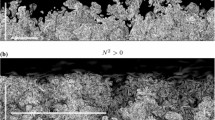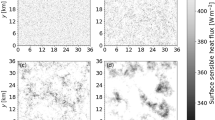Abstract
The interaction between radiation and turbulence in the stable boundary layer over land is explored using an idealized model, with a focus on the surface layer after the evening transition. It is shown that finer vertical resolution is required in transitional boundary layers than in developed ones. In very light winds radiative cooling determines the temperature profile, even if similarity functions without a critical Richardson number are used; standard surface similarity theory applied over thick layers then yields poor forecasts of near-surface air temperatures. These points are illustrated with field data. Simulations of the developing nocturnal boundary layer are used to explore the wider role of radiation. Comparatively, radiation is less significant within the developed stable boundary layer than during the transition; although, as previous studies have found, it remains important towards the top of the stable layer and in the residual layer. Near the ground, reducing the surface emissivity below one is found to yield modest relative radiative warming rather than intense cooling, which reduces the potential importance of radiation in the developed surface layer. The profile of the radiative heating rate may be strongly dependent on other processes, leading to quite varied behaviour.
Similar content being viewed by others
References
André JC, Mahrt L (1981) The nocturnal surface inversion and influence of clear-air radiative cooling. J Atmos Sci 39: 864–878
Batchelor GK (1967) Introduction to fluid dynamics, 1st edn. Cambridge University Press, Cambridge, 618 pp
Beare RJ, Cuxart J, Holtslag AAM, Esau I, Golaz JC, Jimenez MA, Khairoutdinov M, Kosovic B, Lewellen D, Lund TS, Lundquist JK, McCabe A, MacVean MK, Moene AF, Noh Y, Raasch S, Sullivan P (2006) An intercomparison of large-eddy simulations of the stable boundary layer. Boundary-Layer Meteorol 118: 247–272
Beljaars ACM, Holtslag AAM (1991) Flux parametrization over land surfaces for atmospheric models. J Appl Meteorol 30: 327–341
Brost RA, Wyngaard JC (1978) A model study of the stably stratified planetary boundary layer. Boundary-Layer Meteorol 35: 1427–1440
Businger JA, Wyngaard J, Izumi Y, Bradley EF (1971) Flux-profile relationships in the atmospheric surface layer. J Atmos Sci 28: 181–189
Coantic M, Simonin O (1984) Radiative effects on turbulent temperature spectra in the planetary boundary layer. J Atmos Sci 41: 2629–2651
Delage Y (1997) Parameterising sub-grid vertical transport in atmospheric models under statically stable conditions. Boundary-Layer Meteorol 82: 23–48
Dias NL, Brutsaert W (1998) Radiative effects on temperature in the stable boundary layer. Boundary-Layer Meteorol 89: 141–159
Duynkerke PG (1999) Turbulence, radiation and fog in Dutch stable boundary layers. Boundary-Layer Meteorol 90: 447–477
Edwards JM, Slingo A (1996) Studies with a flexible new radiation code. I: choosing a configuration for a large-scale model. Q J Roy Meteorol Soc 122: 689–719
Elliot WP (1964) The height variation of vertical heat fluxes near the ground. Q J Roy Meteorol Soc 90: 260–265
Estournel C, Guedalia D (1985) Inflence of geostrophic wind on atmospheric nocturnal cooling. J Atmos Sci 42: 2695–2698
Funk JP (1960) Measured radiative flux divergence near the ground at night. Q J Roy Meteorol Soc 86: 382–389
Garratt JR, Brost RA (1981) Radiative cooling rates within and above the nocturnal boundary layer. J Atmos Sci 38: 2730–2746
Garratt JR, Hicks BB (1973) Momentum, heat and water vapour transfer to and from natural and artificial surfaces. Q J Roy Meteorol Soc 99: 680–687
Gopalakrishnan SG, Sharan M, McNider RT, Singh MP (1998) Study of radiative and turbulent processes in the stable boundary layer under weak wind conditions. J Atmos Sci 55: 954–960
Ha KJ, Mahrt L (2001) Radiative and turbulent fluxes in the nocturnal boundary layer. Tellus 55: 317–327
Hanjalić K, Launder BE (1972) Fully developed asymmetric flow in a plane channel. J Fluid Mech 51: 301–335
Holtslag AAM, DeBruin HAR (1988) Applied modelling of the nighttime surface energy balance over land. J Clim Appl Meteorol 27: 689–704
Kondo J (1971) Effect of radiative heat transfer on profiles of wind temperature and water vapor in the atmospheric boundary layer. J Meteorol Soc Jpn 49: 75–94
Nieuwstadt FTM (1984) The turbulent structure of the stable, nocturnal boundary layer. J Atmos Sci 41: 2202–2216
Owen PR, Thomson WR (1963) Heat transfer across rough surfaces. J Fluid Mech 15: 321–334
Savijärvi H (2006) Radiative and turbulent heating rates in the clear-air boundary layer. Q J Roy Meteorol Soc 132: 147–161
Spiegel EA (1957) The smoothing of temperature fluctuations by radiative transfer. Astrophys J 126: 202–207
Tjemkes SA, Duynkerke P (1989) The nocturnal boundary layer: model calculations compared with observations. J Appl Meteorol 28: 161–175
Wyngaard JC (1975) Modeling the planetary boundary layer—extension to the stable case. Boundary-Layer Meteorol 9: 441–460
Author information
Authors and Affiliations
Corresponding author
Rights and permissions
About this article
Cite this article
Edwards, J.M. Radiative Processes in the Stable Boundary Layer: Part II. The Development of the Nocturnal Boundary Layer. Boundary-Layer Meteorol 131, 127–146 (2009). https://doi.org/10.1007/s10546-009-9363-9
Received:
Accepted:
Published:
Issue Date:
DOI: https://doi.org/10.1007/s10546-009-9363-9




